Analyzing Leadership and Change Management Strategies: Tesco's Report
VerifiedAdded on 2021/02/19
|19
|5321
|18
Report
AI Summary
This report provides a comprehensive analysis of organizational change within Tesco, a major player in the grocery industry. It begins by comparing the impact of organizational strategies and structures between Tesco and Marks and Spencer, focusing on technology, organizational strategies, structure, operational methods, organizational culture, merger and acquisition, and training. The report then delves into the internal and external drivers of change affecting leadership, teams, and individuals, discussing factors like innovation, strategy adjustments, employee dissatisfaction, and globalization. It explores measures to minimize the negative impacts of change on organizational behavior and examines Lewin's model of change management and its influence on leadership decision-making. Finally, the report analyzes various leadership approaches in dealing with organizational changes, providing a well-rounded understanding of change management practices within a large organization like Tesco.
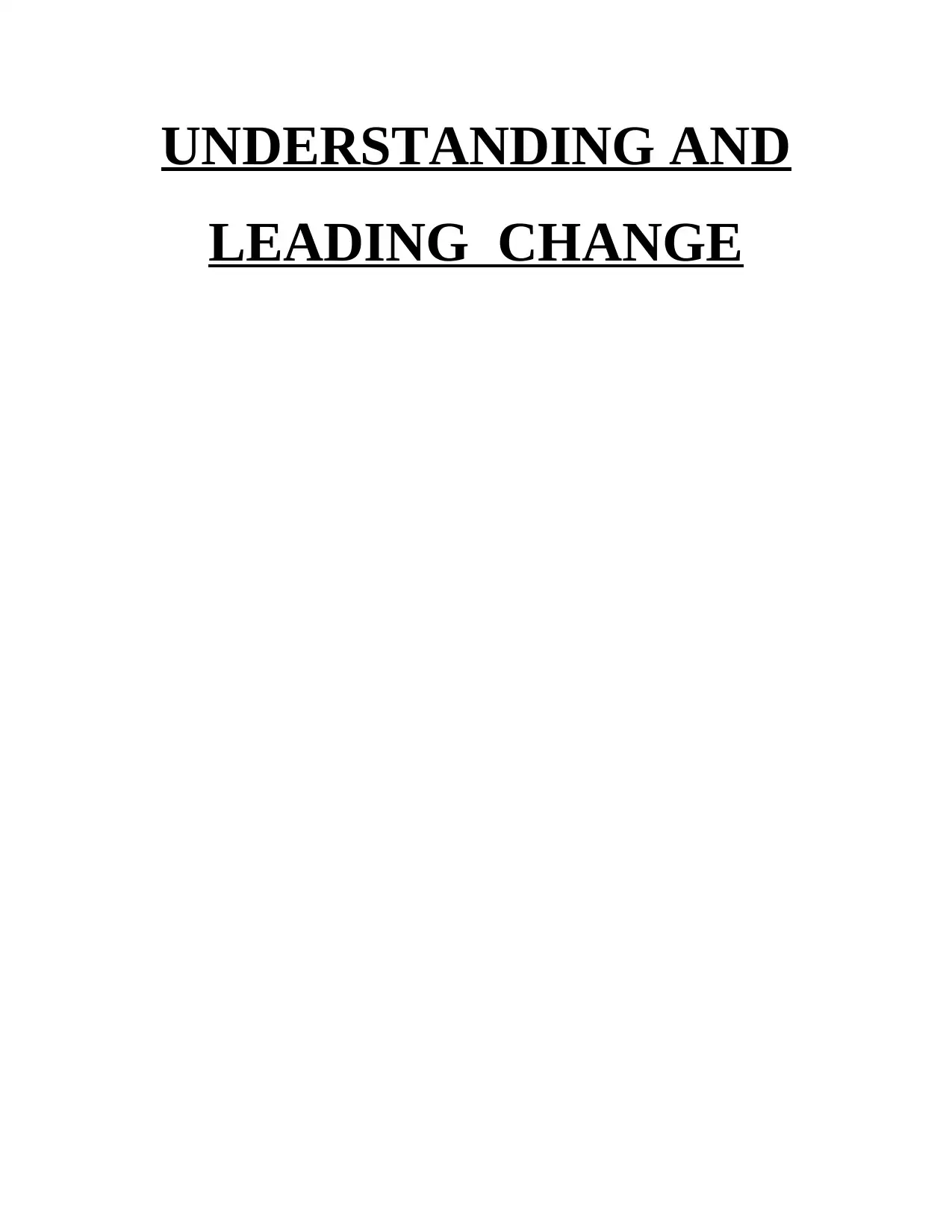
UNDERSTANDING AND
LEADING CHANGE
LEADING CHANGE
Paraphrase This Document
Need a fresh take? Get an instant paraphrase of this document with our AI Paraphraser
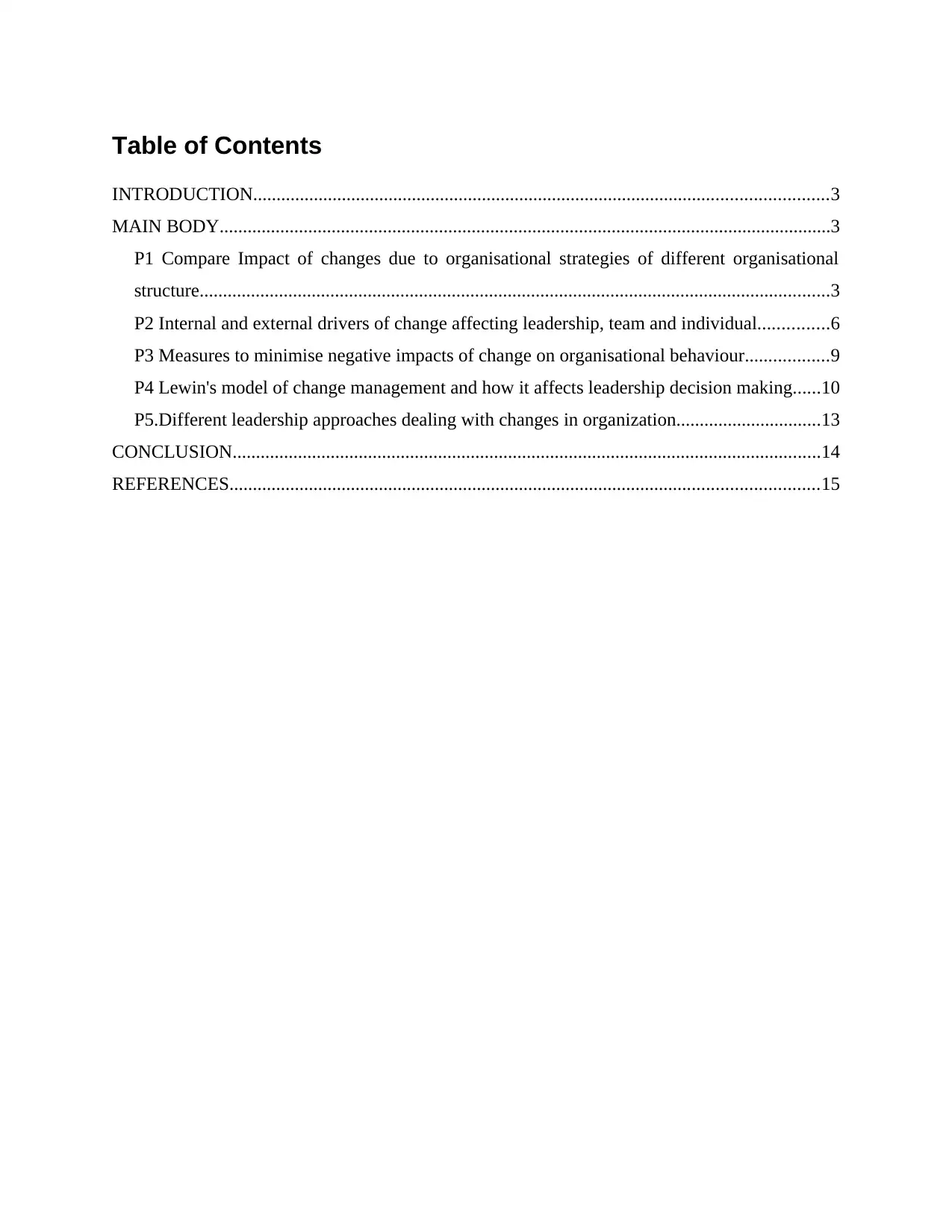
Table of Contents
INTRODUCTION...........................................................................................................................3
MAIN BODY...................................................................................................................................3
P1 Compare Impact of changes due to organisational strategies of different organisational
structure.......................................................................................................................................3
P2 Internal and external drivers of change affecting leadership, team and individual...............6
P3 Measures to minimise negative impacts of change on organisational behaviour..................9
P4 Lewin's model of change management and how it affects leadership decision making......10
P5.Different leadership approaches dealing with changes in organization...............................13
CONCLUSION..............................................................................................................................14
REFERENCES..............................................................................................................................15
INTRODUCTION...........................................................................................................................3
MAIN BODY...................................................................................................................................3
P1 Compare Impact of changes due to organisational strategies of different organisational
structure.......................................................................................................................................3
P2 Internal and external drivers of change affecting leadership, team and individual...............6
P3 Measures to minimise negative impacts of change on organisational behaviour..................9
P4 Lewin's model of change management and how it affects leadership decision making......10
P5.Different leadership approaches dealing with changes in organization...............................13
CONCLUSION..............................................................................................................................14
REFERENCES..............................................................................................................................15
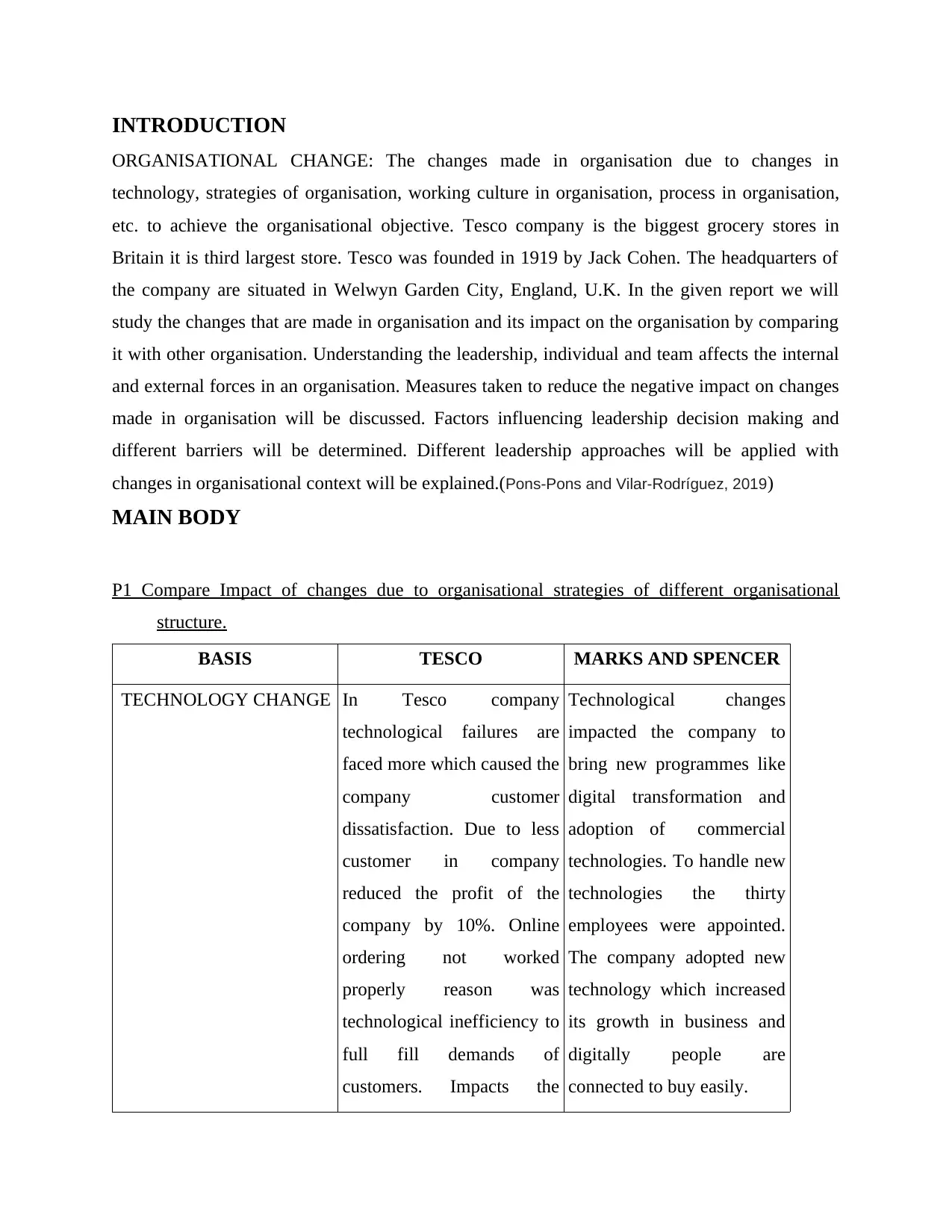
INTRODUCTION
ORGANISATIONAL CHANGE: The changes made in organisation due to changes in
technology, strategies of organisation, working culture in organisation, process in organisation,
etc. to achieve the organisational objective. Tesco company is the biggest grocery stores in
Britain it is third largest store. Tesco was founded in 1919 by Jack Cohen. The headquarters of
the company are situated in Welwyn Garden City, England, U.K. In the given report we will
study the changes that are made in organisation and its impact on the organisation by comparing
it with other organisation. Understanding the leadership, individual and team affects the internal
and external forces in an organisation. Measures taken to reduce the negative impact on changes
made in organisation will be discussed. Factors influencing leadership decision making and
different barriers will be determined. Different leadership approaches will be applied with
changes in organisational context will be explained.(Pons-Pons and Vilar-Rodríguez, 2019)
MAIN BODY
P1 Compare Impact of changes due to organisational strategies of different organisational
structure.
BASIS TESCO MARKS AND SPENCER
TECHNOLOGY CHANGE In Tesco company
technological failures are
faced more which caused the
company customer
dissatisfaction. Due to less
customer in company
reduced the profit of the
company by 10%. Online
ordering not worked
properly reason was
technological inefficiency to
full fill demands of
customers. Impacts the
Technological changes
impacted the company to
bring new programmes like
digital transformation and
adoption of commercial
technologies. To handle new
technologies the thirty
employees were appointed.
The company adopted new
technology which increased
its growth in business and
digitally people are
connected to buy easily.
ORGANISATIONAL CHANGE: The changes made in organisation due to changes in
technology, strategies of organisation, working culture in organisation, process in organisation,
etc. to achieve the organisational objective. Tesco company is the biggest grocery stores in
Britain it is third largest store. Tesco was founded in 1919 by Jack Cohen. The headquarters of
the company are situated in Welwyn Garden City, England, U.K. In the given report we will
study the changes that are made in organisation and its impact on the organisation by comparing
it with other organisation. Understanding the leadership, individual and team affects the internal
and external forces in an organisation. Measures taken to reduce the negative impact on changes
made in organisation will be discussed. Factors influencing leadership decision making and
different barriers will be determined. Different leadership approaches will be applied with
changes in organisational context will be explained.(Pons-Pons and Vilar-Rodríguez, 2019)
MAIN BODY
P1 Compare Impact of changes due to organisational strategies of different organisational
structure.
BASIS TESCO MARKS AND SPENCER
TECHNOLOGY CHANGE In Tesco company
technological failures are
faced more which caused the
company customer
dissatisfaction. Due to less
customer in company
reduced the profit of the
company by 10%. Online
ordering not worked
properly reason was
technological inefficiency to
full fill demands of
customers. Impacts the
Technological changes
impacted the company to
bring new programmes like
digital transformation and
adoption of commercial
technologies. To handle new
technologies the thirty
employees were appointed.
The company adopted new
technology which increased
its growth in business and
digitally people are
connected to buy easily.
⊘ This is a preview!⊘
Do you want full access?
Subscribe today to unlock all pages.

Trusted by 1+ million students worldwide
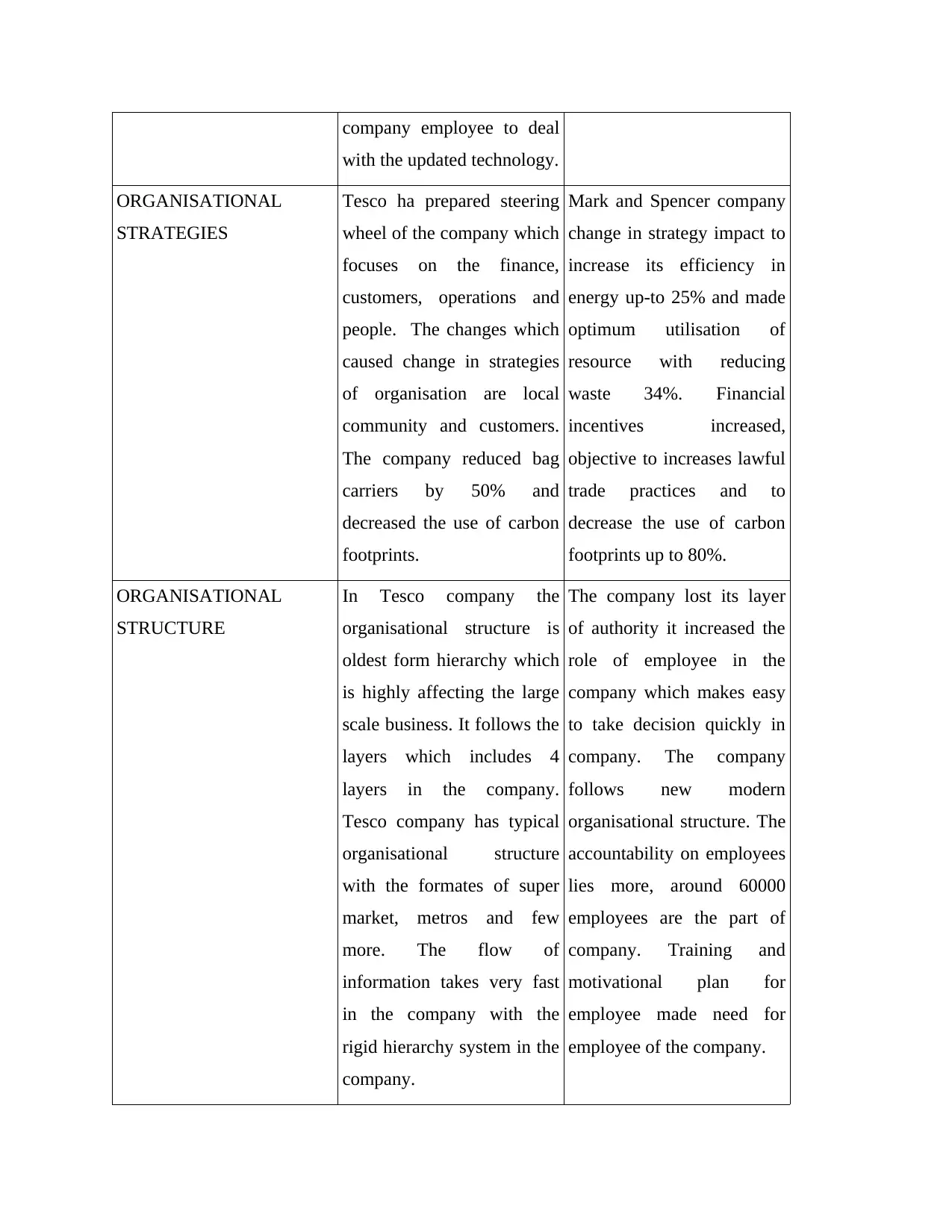
company employee to deal
with the updated technology.
ORGANISATIONAL
STRATEGIES
Tesco ha prepared steering
wheel of the company which
focuses on the finance,
customers, operations and
people. The changes which
caused change in strategies
of organisation are local
community and customers.
The company reduced bag
carriers by 50% and
decreased the use of carbon
footprints.
Mark and Spencer company
change in strategy impact to
increase its efficiency in
energy up-to 25% and made
optimum utilisation of
resource with reducing
waste 34%. Financial
incentives increased,
objective to increases lawful
trade practices and to
decrease the use of carbon
footprints up to 80%.
ORGANISATIONAL
STRUCTURE
In Tesco company the
organisational structure is
oldest form hierarchy which
is highly affecting the large
scale business. It follows the
layers which includes 4
layers in the company.
Tesco company has typical
organisational structure
with the formates of super
market, metros and few
more. The flow of
information takes very fast
in the company with the
rigid hierarchy system in the
company.
The company lost its layer
of authority it increased the
role of employee in the
company which makes easy
to take decision quickly in
company. The company
follows new modern
organisational structure. The
accountability on employees
lies more, around 60000
employees are the part of
company. Training and
motivational plan for
employee made need for
employee of the company.
with the updated technology.
ORGANISATIONAL
STRATEGIES
Tesco ha prepared steering
wheel of the company which
focuses on the finance,
customers, operations and
people. The changes which
caused change in strategies
of organisation are local
community and customers.
The company reduced bag
carriers by 50% and
decreased the use of carbon
footprints.
Mark and Spencer company
change in strategy impact to
increase its efficiency in
energy up-to 25% and made
optimum utilisation of
resource with reducing
waste 34%. Financial
incentives increased,
objective to increases lawful
trade practices and to
decrease the use of carbon
footprints up to 80%.
ORGANISATIONAL
STRUCTURE
In Tesco company the
organisational structure is
oldest form hierarchy which
is highly affecting the large
scale business. It follows the
layers which includes 4
layers in the company.
Tesco company has typical
organisational structure
with the formates of super
market, metros and few
more. The flow of
information takes very fast
in the company with the
rigid hierarchy system in the
company.
The company lost its layer
of authority it increased the
role of employee in the
company which makes easy
to take decision quickly in
company. The company
follows new modern
organisational structure. The
accountability on employees
lies more, around 60000
employees are the part of
company. Training and
motivational plan for
employee made need for
employee of the company.
Paraphrase This Document
Need a fresh take? Get an instant paraphrase of this document with our AI Paraphraser
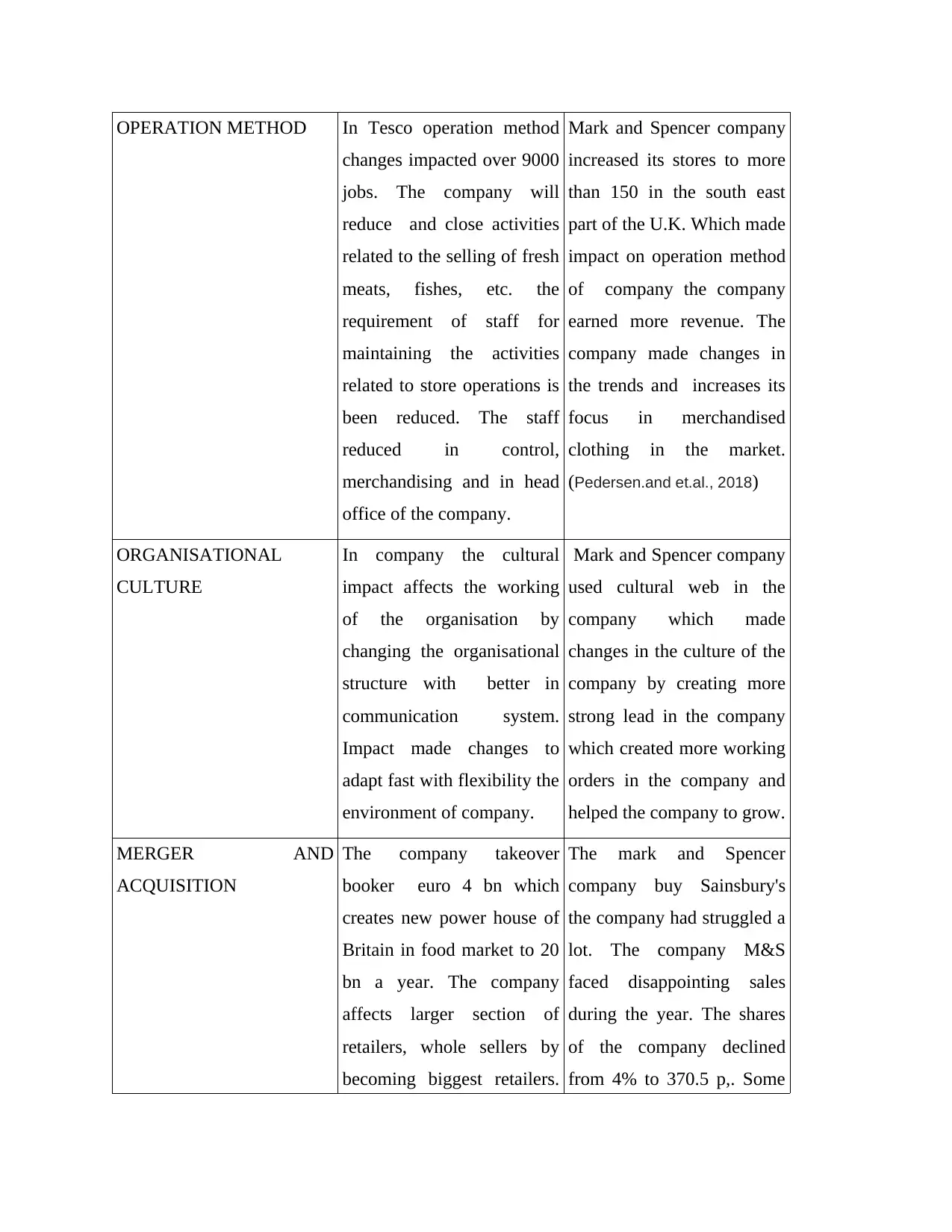
OPERATION METHOD In Tesco operation method
changes impacted over 9000
jobs. The company will
reduce and close activities
related to the selling of fresh
meats, fishes, etc. the
requirement of staff for
maintaining the activities
related to store operations is
been reduced. The staff
reduced in control,
merchandising and in head
office of the company.
Mark and Spencer company
increased its stores to more
than 150 in the south east
part of the U.K. Which made
impact on operation method
of company the company
earned more revenue. The
company made changes in
the trends and increases its
focus in merchandised
clothing in the market.
(Pedersen.and et.al., 2018)
ORGANISATIONAL
CULTURE
In company the cultural
impact affects the working
of the organisation by
changing the organisational
structure with better in
communication system.
Impact made changes to
adapt fast with flexibility the
environment of company.
Mark and Spencer company
used cultural web in the
company which made
changes in the culture of the
company by creating more
strong lead in the company
which created more working
orders in the company and
helped the company to grow.
MERGER AND
ACQUISITION
The company takeover
booker euro 4 bn which
creates new power house of
Britain in food market to 20
bn a year. The company
affects larger section of
retailers, whole sellers by
becoming biggest retailers.
The mark and Spencer
company buy Sainsbury's
the company had struggled a
lot. The company M&S
faced disappointing sales
during the year. The shares
of the company declined
from 4% to 370.5 p,. Some
changes impacted over 9000
jobs. The company will
reduce and close activities
related to the selling of fresh
meats, fishes, etc. the
requirement of staff for
maintaining the activities
related to store operations is
been reduced. The staff
reduced in control,
merchandising and in head
office of the company.
Mark and Spencer company
increased its stores to more
than 150 in the south east
part of the U.K. Which made
impact on operation method
of company the company
earned more revenue. The
company made changes in
the trends and increases its
focus in merchandised
clothing in the market.
(Pedersen.and et.al., 2018)
ORGANISATIONAL
CULTURE
In company the cultural
impact affects the working
of the organisation by
changing the organisational
structure with better in
communication system.
Impact made changes to
adapt fast with flexibility the
environment of company.
Mark and Spencer company
used cultural web in the
company which made
changes in the culture of the
company by creating more
strong lead in the company
which created more working
orders in the company and
helped the company to grow.
MERGER AND
ACQUISITION
The company takeover
booker euro 4 bn which
creates new power house of
Britain in food market to 20
bn a year. The company
affects larger section of
retailers, whole sellers by
becoming biggest retailers.
The mark and Spencer
company buy Sainsbury's
the company had struggled a
lot. The company M&S
faced disappointing sales
during the year. The shares
of the company declined
from 4% to 370.5 p,. Some
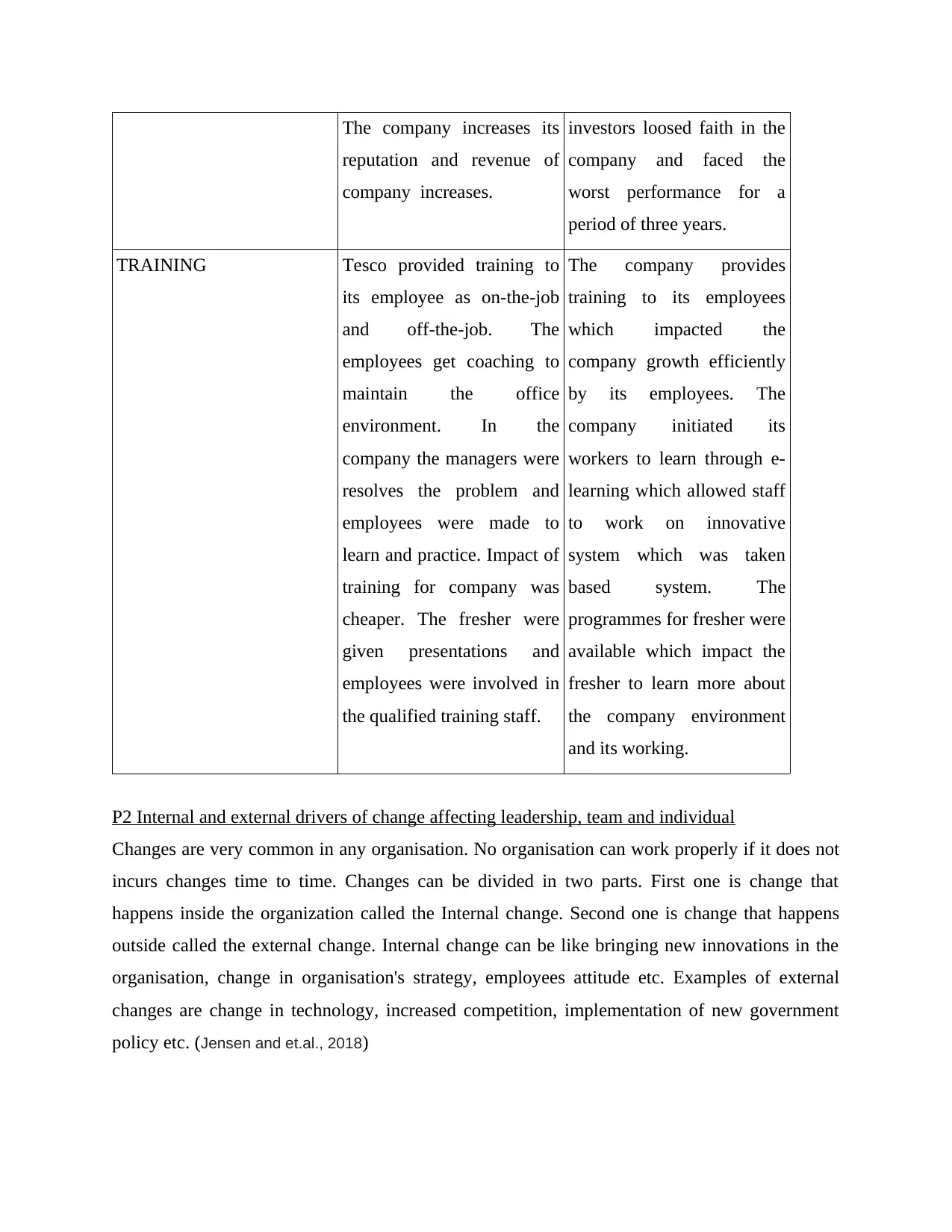
The company increases its
reputation and revenue of
company increases.
investors loosed faith in the
company and faced the
worst performance for a
period of three years.
TRAINING Tesco provided training to
its employee as on-the-job
and off-the-job. The
employees get coaching to
maintain the office
environment. In the
company the managers were
resolves the problem and
employees were made to
learn and practice. Impact of
training for company was
cheaper. The fresher were
given presentations and
employees were involved in
the qualified training staff.
The company provides
training to its employees
which impacted the
company growth efficiently
by its employees. The
company initiated its
workers to learn through e-
learning which allowed staff
to work on innovative
system which was taken
based system. The
programmes for fresher were
available which impact the
fresher to learn more about
the company environment
and its working.
P2 Internal and external drivers of change affecting leadership, team and individual
Changes are very common in any organisation. No organisation can work properly if it does not
incurs changes time to time. Changes can be divided in two parts. First one is change that
happens inside the organization called the Internal change. Second one is change that happens
outside called the external change. Internal change can be like bringing new innovations in the
organisation, change in organisation's strategy, employees attitude etc. Examples of external
changes are change in technology, increased competition, implementation of new government
policy etc. (Jensen and et.al., 2018)
reputation and revenue of
company increases.
investors loosed faith in the
company and faced the
worst performance for a
period of three years.
TRAINING Tesco provided training to
its employee as on-the-job
and off-the-job. The
employees get coaching to
maintain the office
environment. In the
company the managers were
resolves the problem and
employees were made to
learn and practice. Impact of
training for company was
cheaper. The fresher were
given presentations and
employees were involved in
the qualified training staff.
The company provides
training to its employees
which impacted the
company growth efficiently
by its employees. The
company initiated its
workers to learn through e-
learning which allowed staff
to work on innovative
system which was taken
based system. The
programmes for fresher were
available which impact the
fresher to learn more about
the company environment
and its working.
P2 Internal and external drivers of change affecting leadership, team and individual
Changes are very common in any organisation. No organisation can work properly if it does not
incurs changes time to time. Changes can be divided in two parts. First one is change that
happens inside the organization called the Internal change. Second one is change that happens
outside called the external change. Internal change can be like bringing new innovations in the
organisation, change in organisation's strategy, employees attitude etc. Examples of external
changes are change in technology, increased competition, implementation of new government
policy etc. (Jensen and et.al., 2018)
⊘ This is a preview!⊘
Do you want full access?
Subscribe today to unlock all pages.

Trusted by 1+ million students worldwide
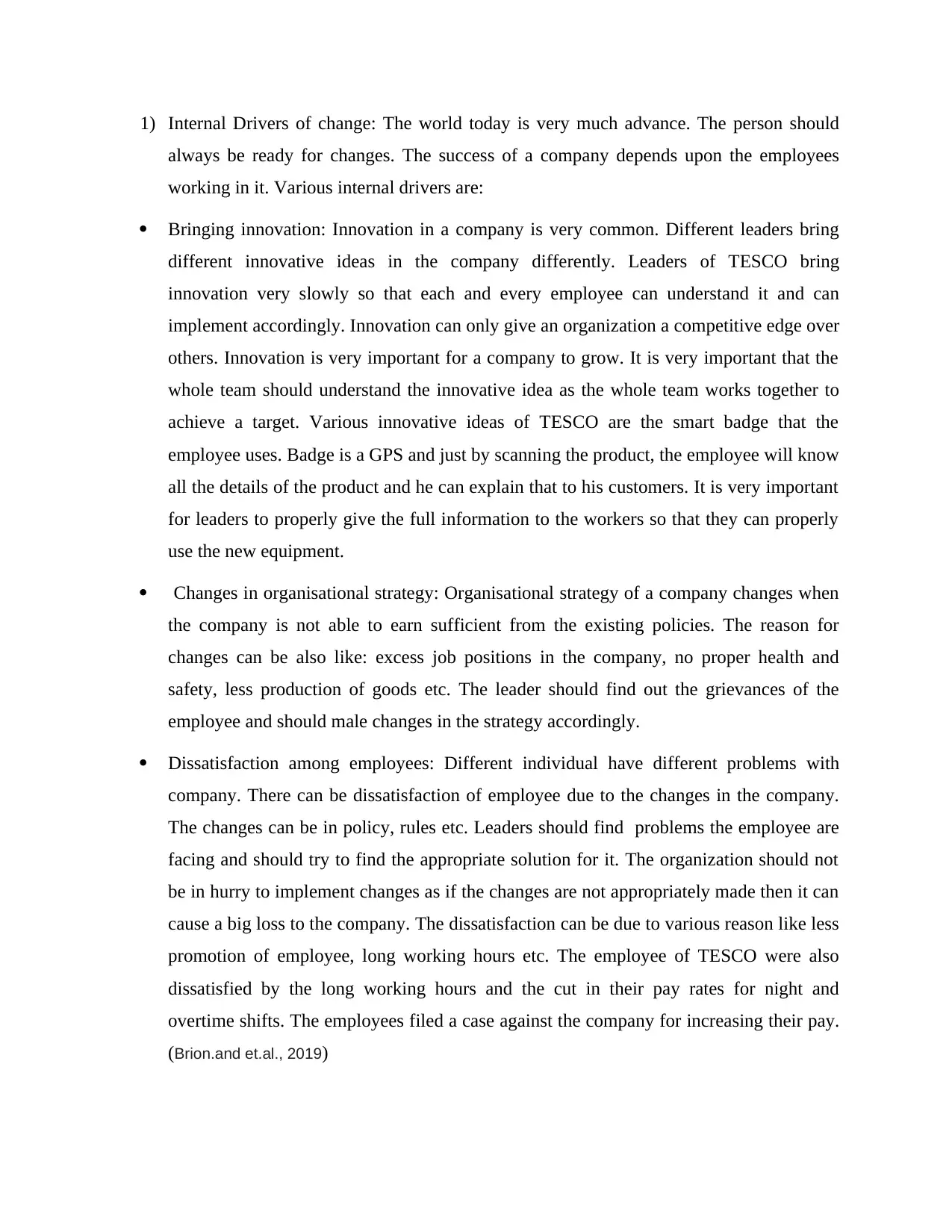
1) Internal Drivers of change: The world today is very much advance. The person should
always be ready for changes. The success of a company depends upon the employees
working in it. Various internal drivers are:
Bringing innovation: Innovation in a company is very common. Different leaders bring
different innovative ideas in the company differently. Leaders of TESCO bring
innovation very slowly so that each and every employee can understand it and can
implement accordingly. Innovation can only give an organization a competitive edge over
others. Innovation is very important for a company to grow. It is very important that the
whole team should understand the innovative idea as the whole team works together to
achieve a target. Various innovative ideas of TESCO are the smart badge that the
employee uses. Badge is a GPS and just by scanning the product, the employee will know
all the details of the product and he can explain that to his customers. It is very important
for leaders to properly give the full information to the workers so that they can properly
use the new equipment.
Changes in organisational strategy: Organisational strategy of a company changes when
the company is not able to earn sufficient from the existing policies. The reason for
changes can be also like: excess job positions in the company, no proper health and
safety, less production of goods etc. The leader should find out the grievances of the
employee and should male changes in the strategy accordingly.
Dissatisfaction among employees: Different individual have different problems with
company. There can be dissatisfaction of employee due to the changes in the company.
The changes can be in policy, rules etc. Leaders should find problems the employee are
facing and should try to find the appropriate solution for it. The organization should not
be in hurry to implement changes as if the changes are not appropriately made then it can
cause a big loss to the company. The dissatisfaction can be due to various reason like less
promotion of employee, long working hours etc. The employee of TESCO were also
dissatisfied by the long working hours and the cut in their pay rates for night and
overtime shifts. The employees filed a case against the company for increasing their pay.
(Brion.and et.al., 2019)
always be ready for changes. The success of a company depends upon the employees
working in it. Various internal drivers are:
Bringing innovation: Innovation in a company is very common. Different leaders bring
different innovative ideas in the company differently. Leaders of TESCO bring
innovation very slowly so that each and every employee can understand it and can
implement accordingly. Innovation can only give an organization a competitive edge over
others. Innovation is very important for a company to grow. It is very important that the
whole team should understand the innovative idea as the whole team works together to
achieve a target. Various innovative ideas of TESCO are the smart badge that the
employee uses. Badge is a GPS and just by scanning the product, the employee will know
all the details of the product and he can explain that to his customers. It is very important
for leaders to properly give the full information to the workers so that they can properly
use the new equipment.
Changes in organisational strategy: Organisational strategy of a company changes when
the company is not able to earn sufficient from the existing policies. The reason for
changes can be also like: excess job positions in the company, no proper health and
safety, less production of goods etc. The leader should find out the grievances of the
employee and should male changes in the strategy accordingly.
Dissatisfaction among employees: Different individual have different problems with
company. There can be dissatisfaction of employee due to the changes in the company.
The changes can be in policy, rules etc. Leaders should find problems the employee are
facing and should try to find the appropriate solution for it. The organization should not
be in hurry to implement changes as if the changes are not appropriately made then it can
cause a big loss to the company. The dissatisfaction can be due to various reason like less
promotion of employee, long working hours etc. The employee of TESCO were also
dissatisfied by the long working hours and the cut in their pay rates for night and
overtime shifts. The employees filed a case against the company for increasing their pay.
(Brion.and et.al., 2019)
Paraphrase This Document
Need a fresh take? Get an instant paraphrase of this document with our AI Paraphraser
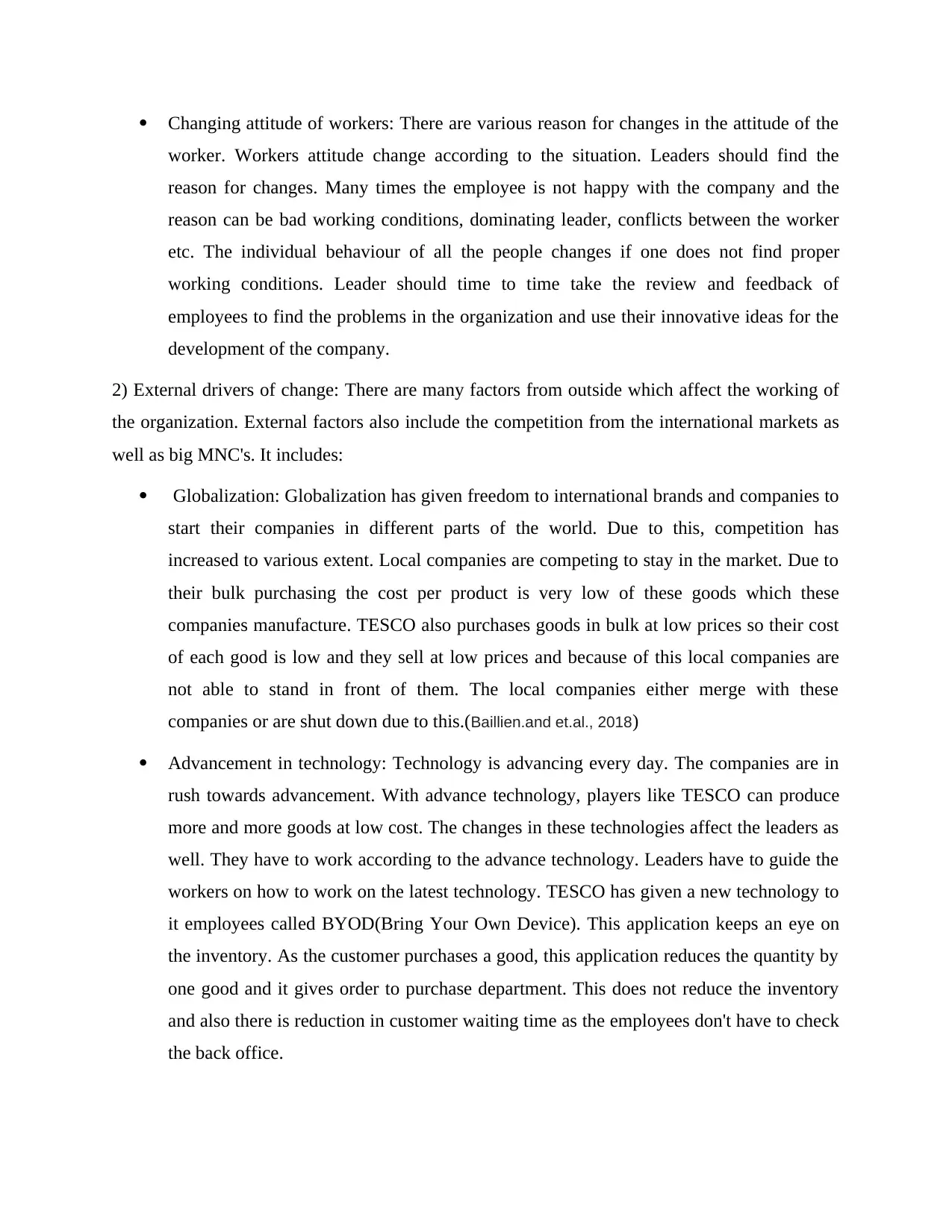
Changing attitude of workers: There are various reason for changes in the attitude of the
worker. Workers attitude change according to the situation. Leaders should find the
reason for changes. Many times the employee is not happy with the company and the
reason can be bad working conditions, dominating leader, conflicts between the worker
etc. The individual behaviour of all the people changes if one does not find proper
working conditions. Leader should time to time take the review and feedback of
employees to find the problems in the organization and use their innovative ideas for the
development of the company.
2) External drivers of change: There are many factors from outside which affect the working of
the organization. External factors also include the competition from the international markets as
well as big MNC's. It includes:
Globalization: Globalization has given freedom to international brands and companies to
start their companies in different parts of the world. Due to this, competition has
increased to various extent. Local companies are competing to stay in the market. Due to
their bulk purchasing the cost per product is very low of these goods which these
companies manufacture. TESCO also purchases goods in bulk at low prices so their cost
of each good is low and they sell at low prices and because of this local companies are
not able to stand in front of them. The local companies either merge with these
companies or are shut down due to this.(Baillien.and et.al., 2018)
Advancement in technology: Technology is advancing every day. The companies are in
rush towards advancement. With advance technology, players like TESCO can produce
more and more goods at low cost. The changes in these technologies affect the leaders as
well. They have to work according to the advance technology. Leaders have to guide the
workers on how to work on the latest technology. TESCO has given a new technology to
it employees called BYOD(Bring Your Own Device). This application keeps an eye on
the inventory. As the customer purchases a good, this application reduces the quantity by
one good and it gives order to purchase department. This does not reduce the inventory
and also there is reduction in customer waiting time as the employees don't have to check
the back office.
worker. Workers attitude change according to the situation. Leaders should find the
reason for changes. Many times the employee is not happy with the company and the
reason can be bad working conditions, dominating leader, conflicts between the worker
etc. The individual behaviour of all the people changes if one does not find proper
working conditions. Leader should time to time take the review and feedback of
employees to find the problems in the organization and use their innovative ideas for the
development of the company.
2) External drivers of change: There are many factors from outside which affect the working of
the organization. External factors also include the competition from the international markets as
well as big MNC's. It includes:
Globalization: Globalization has given freedom to international brands and companies to
start their companies in different parts of the world. Due to this, competition has
increased to various extent. Local companies are competing to stay in the market. Due to
their bulk purchasing the cost per product is very low of these goods which these
companies manufacture. TESCO also purchases goods in bulk at low prices so their cost
of each good is low and they sell at low prices and because of this local companies are
not able to stand in front of them. The local companies either merge with these
companies or are shut down due to this.(Baillien.and et.al., 2018)
Advancement in technology: Technology is advancing every day. The companies are in
rush towards advancement. With advance technology, players like TESCO can produce
more and more goods at low cost. The changes in these technologies affect the leaders as
well. They have to work according to the advance technology. Leaders have to guide the
workers on how to work on the latest technology. TESCO has given a new technology to
it employees called BYOD(Bring Your Own Device). This application keeps an eye on
the inventory. As the customer purchases a good, this application reduces the quantity by
one good and it gives order to purchase department. This does not reduce the inventory
and also there is reduction in customer waiting time as the employees don't have to check
the back office.
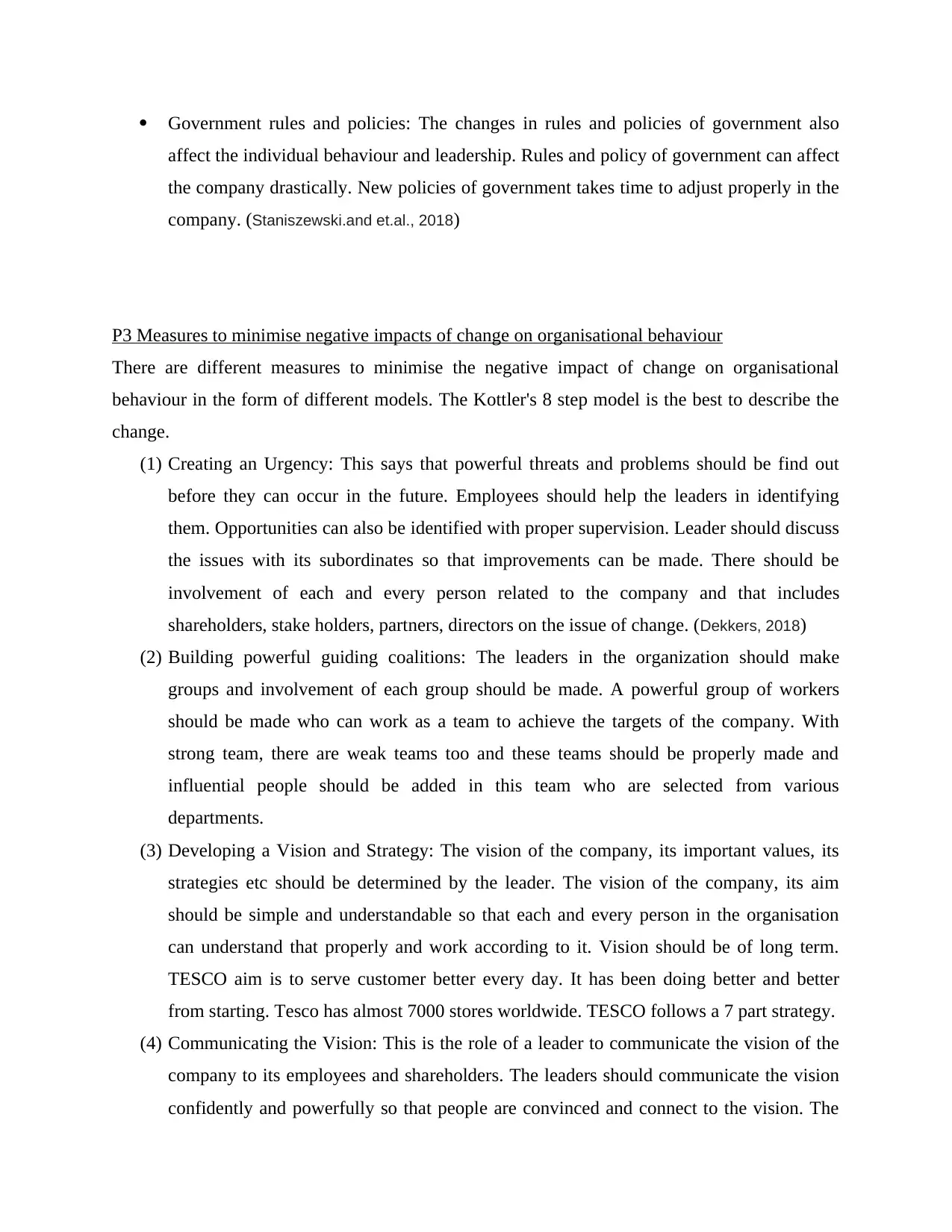
Government rules and policies: The changes in rules and policies of government also
affect the individual behaviour and leadership. Rules and policy of government can affect
the company drastically. New policies of government takes time to adjust properly in the
company. (Staniszewski.and et.al., 2018)
P3 Measures to minimise negative impacts of change on organisational behaviour
There are different measures to minimise the negative impact of change on organisational
behaviour in the form of different models. The Kottler's 8 step model is the best to describe the
change.
(1) Creating an Urgency: This says that powerful threats and problems should be find out
before they can occur in the future. Employees should help the leaders in identifying
them. Opportunities can also be identified with proper supervision. Leader should discuss
the issues with its subordinates so that improvements can be made. There should be
involvement of each and every person related to the company and that includes
shareholders, stake holders, partners, directors on the issue of change. (Dekkers, 2018)
(2) Building powerful guiding coalitions: The leaders in the organization should make
groups and involvement of each group should be made. A powerful group of workers
should be made who can work as a team to achieve the targets of the company. With
strong team, there are weak teams too and these teams should be properly made and
influential people should be added in this team who are selected from various
departments.
(3) Developing a Vision and Strategy: The vision of the company, its important values, its
strategies etc should be determined by the leader. The vision of the company, its aim
should be simple and understandable so that each and every person in the organisation
can understand that properly and work according to it. Vision should be of long term.
TESCO aim is to serve customer better every day. It has been doing better and better
from starting. Tesco has almost 7000 stores worldwide. TESCO follows a 7 part strategy.
(4) Communicating the Vision: This is the role of a leader to communicate the vision of the
company to its employees and shareholders. The leaders should communicate the vision
confidently and powerfully so that people are convinced and connect to the vision. The
affect the individual behaviour and leadership. Rules and policy of government can affect
the company drastically. New policies of government takes time to adjust properly in the
company. (Staniszewski.and et.al., 2018)
P3 Measures to minimise negative impacts of change on organisational behaviour
There are different measures to minimise the negative impact of change on organisational
behaviour in the form of different models. The Kottler's 8 step model is the best to describe the
change.
(1) Creating an Urgency: This says that powerful threats and problems should be find out
before they can occur in the future. Employees should help the leaders in identifying
them. Opportunities can also be identified with proper supervision. Leader should discuss
the issues with its subordinates so that improvements can be made. There should be
involvement of each and every person related to the company and that includes
shareholders, stake holders, partners, directors on the issue of change. (Dekkers, 2018)
(2) Building powerful guiding coalitions: The leaders in the organization should make
groups and involvement of each group should be made. A powerful group of workers
should be made who can work as a team to achieve the targets of the company. With
strong team, there are weak teams too and these teams should be properly made and
influential people should be added in this team who are selected from various
departments.
(3) Developing a Vision and Strategy: The vision of the company, its important values, its
strategies etc should be determined by the leader. The vision of the company, its aim
should be simple and understandable so that each and every person in the organisation
can understand that properly and work according to it. Vision should be of long term.
TESCO aim is to serve customer better every day. It has been doing better and better
from starting. Tesco has almost 7000 stores worldwide. TESCO follows a 7 part strategy.
(4) Communicating the Vision: This is the role of a leader to communicate the vision of the
company to its employees and shareholders. The leaders should communicate the vision
confidently and powerfully so that people are convinced and connect to the vision. The
⊘ This is a preview!⊘
Do you want full access?
Subscribe today to unlock all pages.

Trusted by 1+ million students worldwide
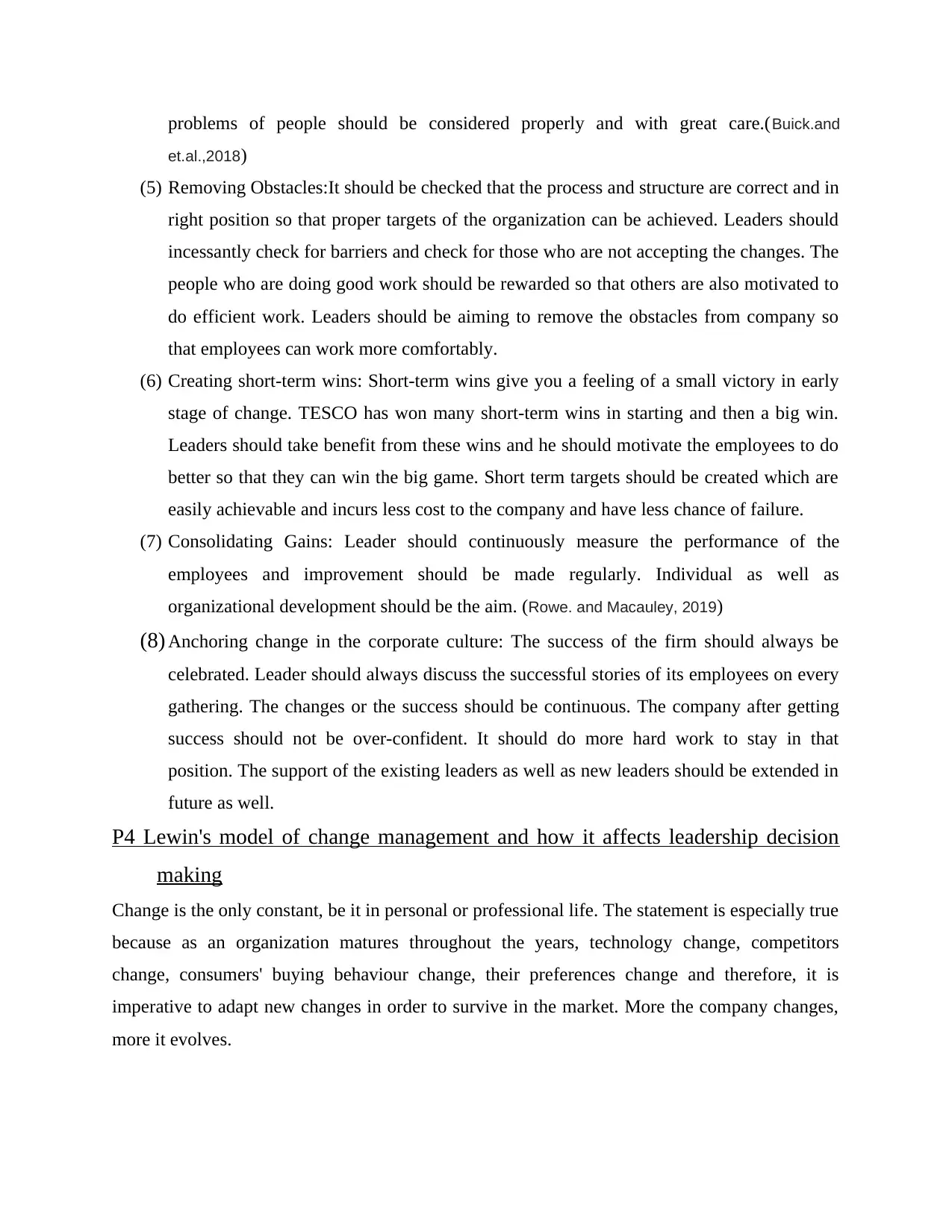
problems of people should be considered properly and with great care.(Buick.and
et.al.,2018)
(5) Removing Obstacles:It should be checked that the process and structure are correct and in
right position so that proper targets of the organization can be achieved. Leaders should
incessantly check for barriers and check for those who are not accepting the changes. The
people who are doing good work should be rewarded so that others are also motivated to
do efficient work. Leaders should be aiming to remove the obstacles from company so
that employees can work more comfortably.
(6) Creating short-term wins: Short-term wins give you a feeling of a small victory in early
stage of change. TESCO has won many short-term wins in starting and then a big win.
Leaders should take benefit from these wins and he should motivate the employees to do
better so that they can win the big game. Short term targets should be created which are
easily achievable and incurs less cost to the company and have less chance of failure.
(7) Consolidating Gains: Leader should continuously measure the performance of the
employees and improvement should be made regularly. Individual as well as
organizational development should be the aim. (Rowe. and Macauley, 2019)
(8) Anchoring change in the corporate culture: The success of the firm should always be
celebrated. Leader should always discuss the successful stories of its employees on every
gathering. The changes or the success should be continuous. The company after getting
success should not be over-confident. It should do more hard work to stay in that
position. The support of the existing leaders as well as new leaders should be extended in
future as well.
P4 Lewin's model of change management and how it affects leadership decision
making
Change is the only constant, be it in personal or professional life. The statement is especially true
because as an organization matures throughout the years, technology change, competitors
change, consumers' buying behaviour change, their preferences change and therefore, it is
imperative to adapt new changes in order to survive in the market. More the company changes,
more it evolves.
et.al.,2018)
(5) Removing Obstacles:It should be checked that the process and structure are correct and in
right position so that proper targets of the organization can be achieved. Leaders should
incessantly check for barriers and check for those who are not accepting the changes. The
people who are doing good work should be rewarded so that others are also motivated to
do efficient work. Leaders should be aiming to remove the obstacles from company so
that employees can work more comfortably.
(6) Creating short-term wins: Short-term wins give you a feeling of a small victory in early
stage of change. TESCO has won many short-term wins in starting and then a big win.
Leaders should take benefit from these wins and he should motivate the employees to do
better so that they can win the big game. Short term targets should be created which are
easily achievable and incurs less cost to the company and have less chance of failure.
(7) Consolidating Gains: Leader should continuously measure the performance of the
employees and improvement should be made regularly. Individual as well as
organizational development should be the aim. (Rowe. and Macauley, 2019)
(8) Anchoring change in the corporate culture: The success of the firm should always be
celebrated. Leader should always discuss the successful stories of its employees on every
gathering. The changes or the success should be continuous. The company after getting
success should not be over-confident. It should do more hard work to stay in that
position. The support of the existing leaders as well as new leaders should be extended in
future as well.
P4 Lewin's model of change management and how it affects leadership decision
making
Change is the only constant, be it in personal or professional life. The statement is especially true
because as an organization matures throughout the years, technology change, competitors
change, consumers' buying behaviour change, their preferences change and therefore, it is
imperative to adapt new changes in order to survive in the market. More the company changes,
more it evolves.
Paraphrase This Document
Need a fresh take? Get an instant paraphrase of this document with our AI Paraphraser
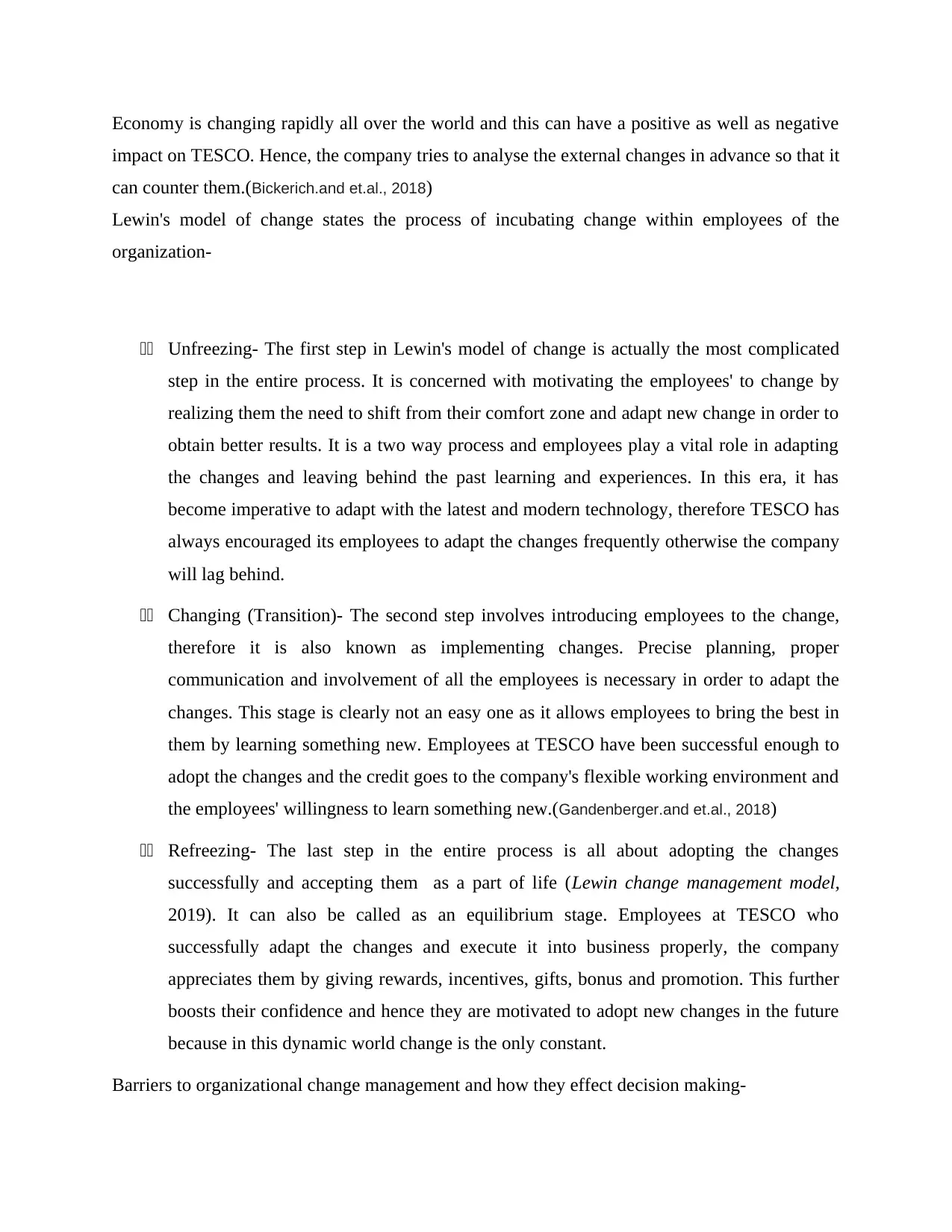
Economy is changing rapidly all over the world and this can have a positive as well as negative
impact on TESCO. Hence, the company tries to analyse the external changes in advance so that it
can counter them.(Bickerich.and et.al., 2018)
Lewin's model of change states the process of incubating change within employees of the
organization-
11 Unfreezing- The first step in Lewin's model of change is actually the most complicated
step in the entire process. It is concerned with motivating the employees' to change by
realizing them the need to shift from their comfort zone and adapt new change in order to
obtain better results. It is a two way process and employees play a vital role in adapting
the changes and leaving behind the past learning and experiences. In this era, it has
become imperative to adapt with the latest and modern technology, therefore TESCO has
always encouraged its employees to adapt the changes frequently otherwise the company
will lag behind.
11 Changing (Transition)- The second step involves introducing employees to the change,
therefore it is also known as implementing changes. Precise planning, proper
communication and involvement of all the employees is necessary in order to adapt the
changes. This stage is clearly not an easy one as it allows employees to bring the best in
them by learning something new. Employees at TESCO have been successful enough to
adopt the changes and the credit goes to the company's flexible working environment and
the employees' willingness to learn something new.(Gandenberger.and et.al., 2018)
11 Refreezing- The last step in the entire process is all about adopting the changes
successfully and accepting them as a part of life (Lewin change management model,
2019). It can also be called as an equilibrium stage. Employees at TESCO who
successfully adapt the changes and execute it into business properly, the company
appreciates them by giving rewards, incentives, gifts, bonus and promotion. This further
boosts their confidence and hence they are motivated to adopt new changes in the future
because in this dynamic world change is the only constant.
Barriers to organizational change management and how they effect decision making-
impact on TESCO. Hence, the company tries to analyse the external changes in advance so that it
can counter them.(Bickerich.and et.al., 2018)
Lewin's model of change states the process of incubating change within employees of the
organization-
11 Unfreezing- The first step in Lewin's model of change is actually the most complicated
step in the entire process. It is concerned with motivating the employees' to change by
realizing them the need to shift from their comfort zone and adapt new change in order to
obtain better results. It is a two way process and employees play a vital role in adapting
the changes and leaving behind the past learning and experiences. In this era, it has
become imperative to adapt with the latest and modern technology, therefore TESCO has
always encouraged its employees to adapt the changes frequently otherwise the company
will lag behind.
11 Changing (Transition)- The second step involves introducing employees to the change,
therefore it is also known as implementing changes. Precise planning, proper
communication and involvement of all the employees is necessary in order to adapt the
changes. This stage is clearly not an easy one as it allows employees to bring the best in
them by learning something new. Employees at TESCO have been successful enough to
adopt the changes and the credit goes to the company's flexible working environment and
the employees' willingness to learn something new.(Gandenberger.and et.al., 2018)
11 Refreezing- The last step in the entire process is all about adopting the changes
successfully and accepting them as a part of life (Lewin change management model,
2019). It can also be called as an equilibrium stage. Employees at TESCO who
successfully adapt the changes and execute it into business properly, the company
appreciates them by giving rewards, incentives, gifts, bonus and promotion. This further
boosts their confidence and hence they are motivated to adopt new changes in the future
because in this dynamic world change is the only constant.
Barriers to organizational change management and how they effect decision making-
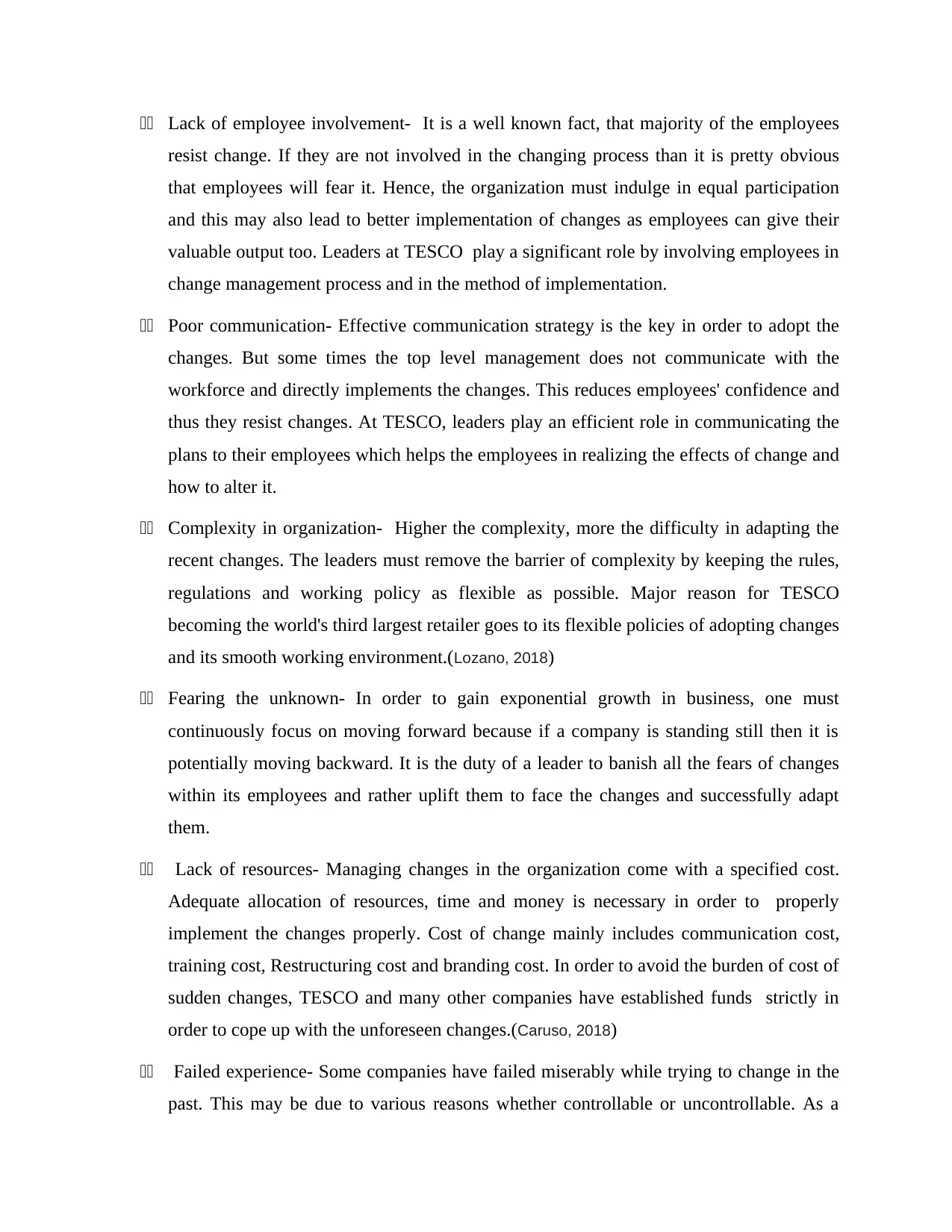
11 Lack of employee involvement- It is a well known fact, that majority of the employees
resist change. If they are not involved in the changing process than it is pretty obvious
that employees will fear it. Hence, the organization must indulge in equal participation
and this may also lead to better implementation of changes as employees can give their
valuable output too. Leaders at TESCO play a significant role by involving employees in
change management process and in the method of implementation.
11 Poor communication- Effective communication strategy is the key in order to adopt the
changes. But some times the top level management does not communicate with the
workforce and directly implements the changes. This reduces employees' confidence and
thus they resist changes. At TESCO, leaders play an efficient role in communicating the
plans to their employees which helps the employees in realizing the effects of change and
how to alter it.
11 Complexity in organization- Higher the complexity, more the difficulty in adapting the
recent changes. The leaders must remove the barrier of complexity by keeping the rules,
regulations and working policy as flexible as possible. Major reason for TESCO
becoming the world's third largest retailer goes to its flexible policies of adopting changes
and its smooth working environment.(Lozano, 2018)
11 Fearing the unknown- In order to gain exponential growth in business, one must
continuously focus on moving forward because if a company is standing still then it is
potentially moving backward. It is the duty of a leader to banish all the fears of changes
within its employees and rather uplift them to face the changes and successfully adapt
them.
11 Lack of resources- Managing changes in the organization come with a specified cost.
Adequate allocation of resources, time and money is necessary in order to properly
implement the changes properly. Cost of change mainly includes communication cost,
training cost, Restructuring cost and branding cost. In order to avoid the burden of cost of
sudden changes, TESCO and many other companies have established funds strictly in
order to cope up with the unforeseen changes.(Caruso, 2018)
11 Failed experience- Some companies have failed miserably while trying to change in the
past. This may be due to various reasons whether controllable or uncontrollable. As a
resist change. If they are not involved in the changing process than it is pretty obvious
that employees will fear it. Hence, the organization must indulge in equal participation
and this may also lead to better implementation of changes as employees can give their
valuable output too. Leaders at TESCO play a significant role by involving employees in
change management process and in the method of implementation.
11 Poor communication- Effective communication strategy is the key in order to adopt the
changes. But some times the top level management does not communicate with the
workforce and directly implements the changes. This reduces employees' confidence and
thus they resist changes. At TESCO, leaders play an efficient role in communicating the
plans to their employees which helps the employees in realizing the effects of change and
how to alter it.
11 Complexity in organization- Higher the complexity, more the difficulty in adapting the
recent changes. The leaders must remove the barrier of complexity by keeping the rules,
regulations and working policy as flexible as possible. Major reason for TESCO
becoming the world's third largest retailer goes to its flexible policies of adopting changes
and its smooth working environment.(Lozano, 2018)
11 Fearing the unknown- In order to gain exponential growth in business, one must
continuously focus on moving forward because if a company is standing still then it is
potentially moving backward. It is the duty of a leader to banish all the fears of changes
within its employees and rather uplift them to face the changes and successfully adapt
them.
11 Lack of resources- Managing changes in the organization come with a specified cost.
Adequate allocation of resources, time and money is necessary in order to properly
implement the changes properly. Cost of change mainly includes communication cost,
training cost, Restructuring cost and branding cost. In order to avoid the burden of cost of
sudden changes, TESCO and many other companies have established funds strictly in
order to cope up with the unforeseen changes.(Caruso, 2018)
11 Failed experience- Some companies have failed miserably while trying to change in the
past. This may be due to various reasons whether controllable or uncontrollable. As a
⊘ This is a preview!⊘
Do you want full access?
Subscribe today to unlock all pages.

Trusted by 1+ million students worldwide
1 out of 19
Related Documents
Your All-in-One AI-Powered Toolkit for Academic Success.
+13062052269
info@desklib.com
Available 24*7 on WhatsApp / Email
![[object Object]](/_next/static/media/star-bottom.7253800d.svg)
Unlock your academic potential
Copyright © 2020–2025 A2Z Services. All Rights Reserved. Developed and managed by ZUCOL.




